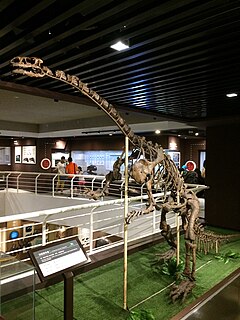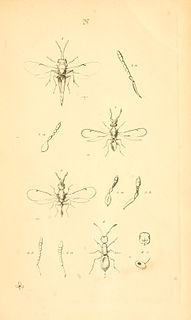
Lufengosaurus is a genus of massospondylid dinosaur which lived during the Early Jurassic period in what is now southwestern China. The dinosaur made international headlines in 2017 when Nature Communications reported scientists' discovery of 195-million-year-old collagen protein in the rib of a Lufengosarus fossil.
Sinocyclocheilus is a genus of freshwater fish in the family Cyprinidae endemic to China, where only found in Guangxi, Guizhou and Yunnan. Almost all of its species live in or around caves and most of these have adaptions typical of cavefish such as a lack of scales, lack of pigmentation and reduced eyes. Several species have an unusual hunchbacked appearance and some of the cave-dwellers have a "horn" on the back, the function of which is unclear. In contrast, the Sinocyclocheilus species that live aboveground, as well as a few found underground, show no clear cavefish adaptions. They are relatively small fish reaching up to 23 cm (9.1 in) in length. The individual species have small ranges and populations, leading to the status of most of the evaluated species as threatened. Many species populations in the genus have yet to be evaluated by the IUCN.

Oreonectes is a genus of fish in the family Nemacheilidae found in the rivers and cave of Asia. Many of these species are troglobitic.

Microgastrinae is a subfamily of braconid wasps, encompassing 2,000 described species, with an estimated 5,000-10,000 total species. This makes it one of the richest subfamilies with the most species of parasitoid wasps.

Theocolax is a parasitic wasp genus in the family Pteromalidae.

Pamphilius is a genus of leaf-rolling sawflies within the Symphyta belonging to the family Pamphiliidae.
Metapelma is a parasitic wasp genus in the family Eupelmidae.

Orchideae is a tribe of orchids in the subfamily Orchidoideae. It has been divided into two subtribes, Orchidinae and Habenariinae. The subtribe Orchidinae alone contains about 1,800 species. However, although some phylogenetic studies have established the monophyly of the subtribes, the generic boundaries are unclear, with many genera as traditionally circumscribed being paraphyletic or even polyphyletic. Species of genera such as Habenaria and Platanthera have been placed into both subtribes. A 2017 molecular phylogenetic study found that both subtribes did form clades, but did not formally recognize Habenariinae, because of missing genera and uncertainty over generic boundaries. The Asian species of Orchideae, in particular, have been subject to repeated changes of generic placement from 2012 onwards.
Liopteridae is a family of wood-boring parasitoid wasps. They occur worldwide with concentrations in the African Tropics. These insects have a petiolate abdomen. There are 10 genera and more than 140 species known.
Heydenia is a genus of wasps in the family Pteromalidae.
Cleonymus is a genus of wasps in the family Pteromalidae.

Thynnidae are a family of large solitary wasps whose larvae are almost universally parasitoids of various beetle larvae, especially those in the superfamily Scarabaeoidea. Until recently, the constituents of this family were classified in the family Tiphiidae, but multiple studies have independently confirmed that thynnids are a separate lineage.
Entedoninae is a subfamily of chalcid wasps from the family Eulophidae which includes over 90 genera.

Eulophinae is a subfamily of chalcid wasps from the family Eulophidae which includes over 90 genera.

Trogus is a genus of parasitoid wasp found in the Holarctic and Neotropic regions. It is placed in the subfamily Ichneumoninae. Trogus species are parasites of larvae and pupae of the swallowtail butterfly family, Papilionidae. The genus consists of twelve extant and one extinct species.

Gennaria griffithii is a species of flowering plant in the family Orchidaceae, native from Afghanistan to China. It is a terrestrial species, with a small tuber and small greenish flowers, found in damp places. It has a complicated taxonomic history, having been transferred between genera several times. When placed in a genus on its own it is correctly known as Dithrix griffithii. In 2015, it was transferred to the genus Gennaria.
Cephalonomia is a genus of parasitoid wasps in the family Bethylidae. There are more than 20 described species in Cephalonomia.

Nanhaipotamon is a genus of freshwater crabs, in the subfamily Potamiscinae, found in southern China and Taiwan. As of 2018, 18 species have been described. The genus is named after the South China Sea, for it occurs mostly in coastal areas.










